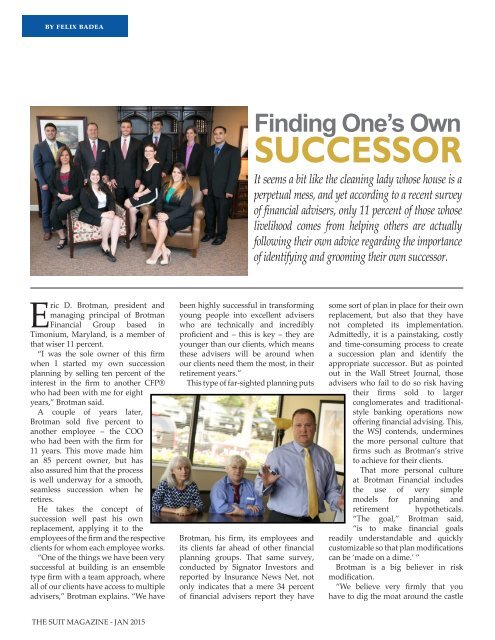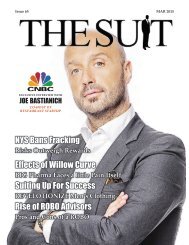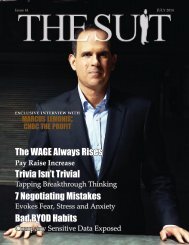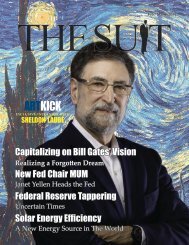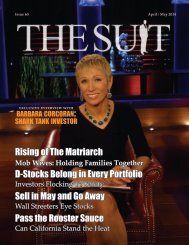Kayla Tausche CNBC
The arrival of January seems to bring out the list-making in the media. There are reviews of the previous year and predictions for the one we are now in. Publications commonly create a list of Top 40 Business People that are under the age of 40 as top entrepreneur’s to watch for the upcoming year. It used to be that 40 was the target for career establishment. Not anymore. In today’s aggressive market place, a long track record of success prior to age 30 is not uncommon. Credit technology is the empowerment of the Millennials. The reality is that the age bracket in which 30 is considered old, don’t just have extensive resumes – they have already formed in irreversible impact. That’s why The Suit Magazine opted to highlight six of these movers and shakers in our first edition for 2015. As expected, our list contains success stories from social media. There is no denying the changes and questions the emergence of social media brings to our world. Yet, our list goes further.
The arrival of January seems to bring out the list-making in the media. There are reviews of the previous year and predictions for the one we are now in. Publications commonly create a list of Top 40 Business People that are under the age of 40 as top entrepreneur’s to watch for the upcoming year. It used to be that 40 was the target for career establishment. Not anymore. In today’s aggressive market place, a long track record of success prior to age 30 is not uncommon. Credit technology is the empowerment of the Millennials. The reality is that the age bracket in which 30 is considered old, don’t just have extensive resumes – they have already formed in irreversible impact. That’s why The Suit Magazine opted to highlight six of these movers and shakers in our first edition for 2015. As expected, our list contains success stories from social media. There is no denying the changes and questions the emergence of social media brings to our world. Yet, our list goes further.
Create successful ePaper yourself
Turn your PDF publications into a flip-book with our unique Google optimized e-Paper software.
y felix badea<br />
Finding One’s Own<br />
SUCCESSOR<br />
It seems a bit like the cleaning lady whose house is a<br />
perpetual mess, and yet according to a recent survey<br />
of financial advisers, only 11 percent of those whose<br />
livelihood comes from helping others are actually<br />
following their own advice regarding the importance<br />
of identifying and grooming their own successor.<br />
Eric D. Brotman, president and<br />
managing principal of Brotman<br />
Financial Group based in<br />
Timonium, Maryland, is a member of<br />
that wiser 11 percent.<br />
“I was the sole owner of this firm<br />
when I started my own succession<br />
planning by selling ten percent of the<br />
interest in the firm to another CFP®<br />
who had been with me for eight<br />
years,” Brotman said.<br />
A couple of years later,<br />
Brotman sold five percent to<br />
another employee – the COO<br />
who had been with the firm for<br />
11 years. This move made him<br />
an 85 percent owner, but has<br />
also assured him that the process<br />
is well underway for a smooth,<br />
seamless succession when he<br />
retires.<br />
He takes the concept of<br />
succession well past his own<br />
replacement, applying it to the<br />
employees of the firm and the respective<br />
clients for whom each employee works.<br />
“One of the things we have been very<br />
successful at building is an ensemble<br />
type firm with a team approach, where<br />
all of our clients have access to multiple<br />
advisers,” Brotman explains. “We have<br />
been highly successful in transforming<br />
young people into excellent advisers<br />
who are technically and incredibly<br />
proficient and – this is key – they are<br />
younger than our clients, which means<br />
these advisers will be around when<br />
our clients need them the most, in their<br />
retirement years.”<br />
This type of far-sighted planning puts<br />
Brotman, his firm, its employees and<br />
its clients far ahead of other financial<br />
planning groups. That same survey,<br />
conducted by Signator Investors and<br />
reported by Insurance News Net, not<br />
only indicates that a mere 34 percent<br />
of financial advisers report they have<br />
some sort of plan in place for their own<br />
replacement, but also that they have<br />
not completed its implementation.<br />
Admittedly, it is a painstaking, costly<br />
and time-consuming process to create<br />
a succession plan and identify the<br />
appropriate successor. But as pointed<br />
out in the Wall Street Journal, those<br />
advisers who fail to do so risk having<br />
their firms sold to larger<br />
conglomerates and traditionalstyle<br />
banking operations now<br />
offering financial advising. This,<br />
the WSJ contends, undermines<br />
the more personal culture that<br />
firms such as Brotman’s strive<br />
to achieve for their clients.<br />
That more personal culture<br />
at Brotman Financial includes<br />
the use of very simple<br />
models for planning and<br />
retirement hypotheticals.<br />
“The goal,” Brotman said,<br />
“is to make financial goals<br />
readily understandable and quickly<br />
customizable so that plan modifications<br />
can be ‘made on a dime.’ ”<br />
Brotman is a big believer in risk<br />
modification.<br />
“We believe very firmly that you<br />
have to dig the moat around the castle<br />
THE SUIT MAGAZINE - JAN 2015


